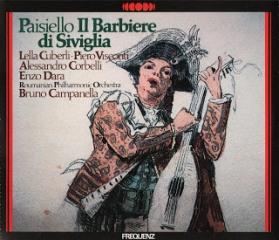Paisiello – Il Barbiere di Siviglia (Campanella) [1982]
Paisiello – Il Barbiere di Siviglia (Campanella) [1982]

CD1 01. sinfonia [0:04:49.32] 02. atto primo [0:01:47.63] 03. diamo alll noia il bando [0:06:35.72] 04. scorsi gia molti peasi [0:04:27.20] 05. lode al ciel, che alfine aperse [0:10:16.33] 06. saper bramate, bella, il mio nome [0:06:32.10] 07. non dubitar, o figaro [0:05:19.17] 08. ma dov'eri tu stordito [0:05:07.53] 09. la calunnia, mio signori [0:07:04.32] 10. veramente ho torto,e vero [0:03:20.68] CD2 01. ma che vuol quest'uom [0:04:40.05] 02. ecco, questo e l'inimico [0:05:56.47] 03. ciusto ciel, che conoscete [0:04:27.30] 04. atto secondo [0:06:28.55] 05. gia riede primavera [0:10:29.68] 06. vuoi tu rosina [0:04:14.70] 07. don basilio giusto cielo [0:04:54.70] 08. quell'uomo certo no ,non sta bne [0:07:16.05] 09. temporale [0:05:19.12] 10. cara, sei tu il mio bene [0:05:23.30] 11. qui rosina fra bricconi [0:03:06.35] 12. allr quando in giovin core [0:01:56.30] Cast: Figaro - Alessandro Corbelli Rosina - Lella Cuberli Il Conte d’Almaviva - Piero Visconti Bartolo - Enzo Dara Don Basilio - Delfo Menicucci Un notaro - Giovanni Savoiardo Un alcade - Franco Ricciardi Roumanian Philharmonic Orchestra Bruno Campanella – conductor
Among the most successful operas of its day, Paisiello's Il barbiere di Siviglia (The Barber of Seville) was subsequently eclipsed by Rossini's work of the same name. Yet even by 1816, the year Rossini's evergreen comedy appeared and of Paisiello's death, the latter's opera was still so popular that some attacked Rossini for turning to the same story. Il Barbiere was written during Paisiello's tenure as maestro di cappella for Empress Catherine II in St. Petersburg, and received its first performance at the Hermitage on September 15, 1776 (although by that time, Paisiello had already left the court to assume a new position in Naples). The libretto for Il Barbiere was most likely written by Giuseppe Petrosellini, and the work is dedicated to Catherine.
The opera is based on the first installment of French playwright Pierre-Augustin Beaumarchais' famous trilogy that also includes Le mariage de Figaro (memorably set by Mozart as Le nozze di Figaro four years after Paisiello's Barber). Although Beaumarchais' Figaro was considered subversive (performances were banned in Mozart's Vienna), the doings of the wily barber Figaro and his aristocratic patron Count Almaviva are less contentious in the opening of the cycle. Indeed, according to the composer's dedication the idea of setting the famous play came from the Empress herself. Il barbiere di Siviglia is cast in four acts, in the course of which Figaro assists a disguised Almaviva in marrying Rosina, the ward of Dr. Bartolo, who himself has designs on the girl. The story is told with the customary alternation of rapid, witty recitative punctuated with arias and ensembles; these reveal Paisiello to have been a master of the theater and the possessor of considerable melodic gifts. The work's only real weakness is the thinly conceived orchestration, which pales next to the brilliant effects in Rossini's setting. Nonetheless, by the standards of the day, Il barbiere di Siviglia is an excellent example of opera buffa; its contemporary success is marked by its rapid transference to such European opera centers as Naples, Venice, Vienna (where it received nearly 100 performances between 1783 and 1804), and London. ---Brian Robins, Rovi
download: uploaded yandex 4shared mediafire solidfiles mega filecloudio nornar
Zmieniony (Sobota, 08 Marzec 2014 10:08)








